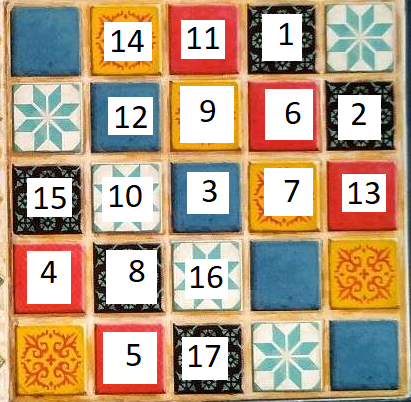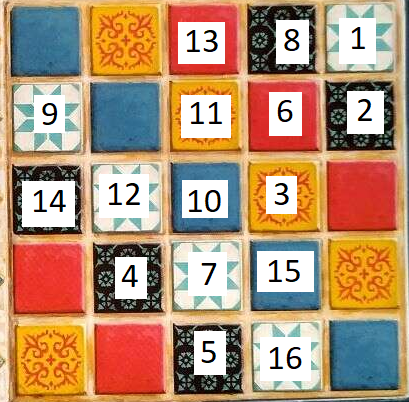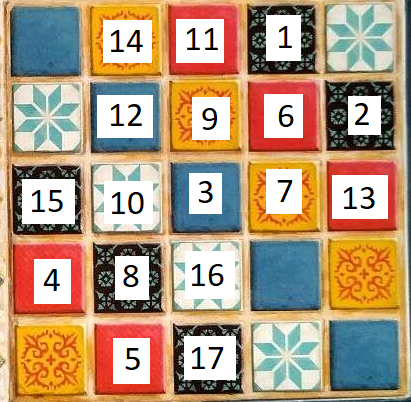
- Move 1: 1 point
- Move 2: 1 point
- Move 3: 4 points
- Move 4: 4 points
- Move 5: 1 point
- Move 6: 1 point
- Move 7: 4 points
- Move 8: 1 point
- Move 9: 4 points
- Move 10: 6 points
- Move 11: 7 points
- Move: 12: 8 points
- Move 13: 7 points
- Move 14: 7 points
- Move 15: 7 points
- Move 16: 7 points
- Move 17: 7 points
- Endgame Bonus: 10 + 10 + 7 + 7 + 2 == 36 Endgame Bonus
- Total Score: 113
Note that while this is “optimal” placements, it is not the best sequence in-game. For example, sequence 8, 9, 10, 11, and 12 are going backwards. I’m not sure how to rewrite my program to account for the top-down placements per round however. So there’s still work to be done.
This was a relatively simple brute-force bot that exhaustively checked all possibilities for the best possible placement. So I’m pretty sure I’ve go the best placement here. Well, maybe it was more “Dynamic Programming”. I worked backwards: I calculated all possible 17-placement endgames (there’s only 1.081 million of them, aka 25-choose-17), and then back-calculated all possible moves back to move#1.
Then I calculate from move#1 forward, choosing the best endgame move now that all possible endgames have been searched. Chess-programming fans would know this as a “Tablebase” approach.
EDIT: Searching the ~60 million possible optimal games proved to be difficult, as my computer ran out of RAM at 2GB (ummm… I got a 32GB system here. WTF Windows?). I’m sure there was some compiler flag I messed up on.
But I did a few heuristics and came up with the following board:

This is a 17-placement across 5 rounds with as many placements on the “top” of the board that I could find with my program.
EDIT:
- Optimal 11 Placement: 58 Points
- Optimal 12 Placement: 63 Points
- Optimal 13 Placement: 73 Points
- Optimal 14 Placement: 82 Points
- Optimal 15 Placement: 91 Points
- Optimal 16 Placement: 99 Points
- Optimal 17 Placement: 113 Points
- Optimal 18 Placement: 123 Points
- Optimal 19 Placement: 136 Points
- Optimal 20 Placement: 147 Points
- Optimal 21 Placement: 163 Points
- Optimal 22 Placement: 174 Points
- Optimal 23 Placement: 192 Points
- Optimal 24 Placement: 211 Points
- Optimal 25 Placement: 240 Points






As mentioned, the first outcome would end the game in turn 14 and also be impossible to place in the first phase of the game. The second solution comes closer but weighs heavily on getting two tile types to get there.
I just got the game and have been loving it but there are many more variables to solve this. Some examples are: group size, and random tiles drawn.
I’ve added a new placement based on a few more heuristics.
The newest placement is theoretically possible in 5 rounds, creates the maximum 113 score, and is biased to have as many placements as “high” up as possible (row1 favored most, row2 next favored, etc. etc.)

